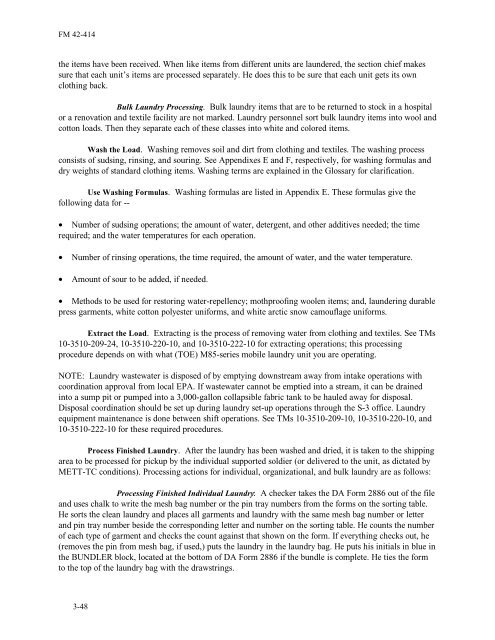Tactics, techniques, and procedures for - Army Electronic ...
Tactics, techniques, and procedures for - Army Electronic ...
Tactics, techniques, and procedures for - Army Electronic ...
Create successful ePaper yourself
Turn your PDF publications into a flip-book with our unique Google optimized e-Paper software.
FM 42-414<br />
the items have been received. When like items from different units are laundered, the section chief makes<br />
sure that each unit’s items are processed separately. He does this to be sure that each unit gets its own<br />
clothing back.<br />
Bulk Laundry Processing. Bulk laundry items that are to be returned to stock in a hospital<br />
or a renovation <strong>and</strong> textile facility are not marked. Laundry personnel sort bulk laundry items into wool <strong>and</strong><br />
cotton loads. Then they separate each of these classes into white <strong>and</strong> colored items.<br />
Wash the Load. Washing removes soil <strong>and</strong> dirt from clothing <strong>and</strong> textiles. The washing process<br />
consists of sudsing, rinsing, <strong>and</strong> souring. See Appendixes E <strong>and</strong> F, respectively, <strong>for</strong> washing <strong>for</strong>mulas <strong>and</strong><br />
dry weights of st<strong>and</strong>ard clothing items. Washing terms are explained in the Glossary <strong>for</strong> clarification.<br />
Use Washing Formulas. Washing <strong>for</strong>mulas are listed in Appendix E. These <strong>for</strong>mulas give the<br />
following data <strong>for</strong> --<br />
• Number of sudsing operations; the amount of water, detergent, <strong>and</strong> other additives needed; the time<br />
required; <strong>and</strong> the water temperatures <strong>for</strong> each operation.<br />
• Number of rinsing operations, the time required, the amount of water, <strong>and</strong> the water temperature.<br />
• Amount of sour to be added, if needed.<br />
• Methods to be used <strong>for</strong> restoring water-repellency; mothproofing woolen items; <strong>and</strong>, laundering durable<br />
press garments, white cotton polyester uni<strong>for</strong>ms, <strong>and</strong> white arctic snow camouflage uni<strong>for</strong>ms.<br />
Extract the Load. Extracting is the process of removing water from clothing <strong>and</strong> textiles. See TMs<br />
10-3510-209-24, 10-3510-220-10, <strong>and</strong> 10-3510-222-10 <strong>for</strong> extracting operations; this processing<br />
procedure depends on with what (TOE) M85-series mobile laundry unit you are operating.<br />
NOTE: Laundry wastewater is disposed of by emptying downstream away from intake operations with<br />
coordination approval from local EPA. If wastewater cannot be emptied into a stream, it can be drained<br />
into a sump pit or pumped into a 3,000-gallon collapsible fabric tank to be hauled away <strong>for</strong> disposal.<br />
Disposal coordination should be set up during laundry set-up operations through the S-3 office. Laundry<br />
equipment maintenance is done between shift operations. See TMs 10-3510-209-10, 10-3510-220-10, <strong>and</strong><br />
10-3510-222-10 <strong>for</strong> these required <strong>procedures</strong>.<br />
Process Finished Laundry. After the laundry has been washed <strong>and</strong> dried, it is taken to the shipping<br />
area to be processed <strong>for</strong> pickup by the individual supported soldier (or delivered to the unit, as dictated by<br />
METT-TC conditions). Processing actions <strong>for</strong> individual, organizational, <strong>and</strong> bulk laundry are as follows:<br />
Processing Finished Individual Laundry: A checker takes the DA Form 2886 out of the file<br />
<strong>and</strong> uses chalk to write the mesh bag number or the pin tray numbers from the <strong>for</strong>ms on the sorting table.<br />
He sorts the clean laundry <strong>and</strong> places all garments <strong>and</strong> laundry with the same mesh bag number or letter<br />
<strong>and</strong> pin tray number beside the corresponding letter <strong>and</strong> number on the sorting table. He counts the number<br />
of each type of garment <strong>and</strong> checks the count against that shown on the <strong>for</strong>m. If everything checks out, he<br />
(removes the pin from mesh bag, if used,) puts the laundry in the laundry bag. He puts his initials in blue in<br />
the BUNDLER block, located at the bottom of DA Form 2886 if the bundle is complete. He ties the <strong>for</strong>m<br />
to the top of the laundry bag with the drawstrings.<br />
3-48

















